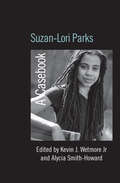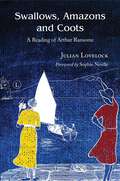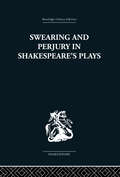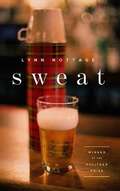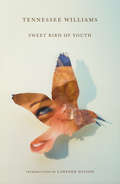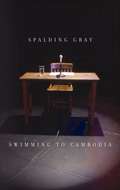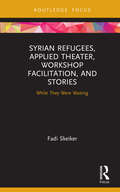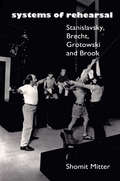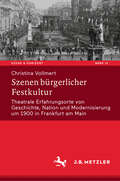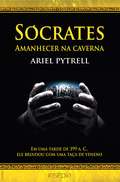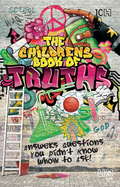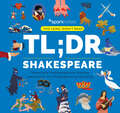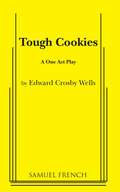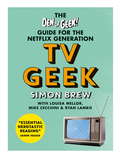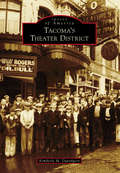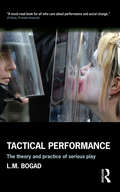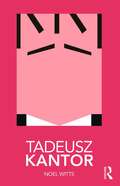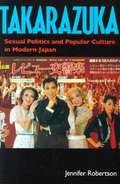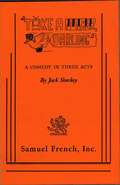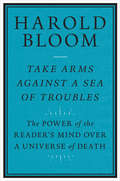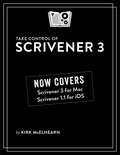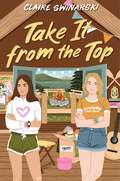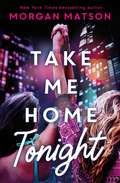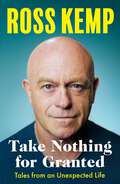- Table View
- List View
Suzan-Lori Parks: A Casebook (Casebooks on Modern Dramatists)
by Kevin J. Wetmore Jr Alycia Smith-HowardSuzan-Lori Parks confirmed herself as one of the most exciting and successful playwrights of her generation when her work Topdog/Underdog was awarded the 2002 Pulitzer Prize, making her the only African American woman to win the award. Despite the cultural weight of this achievement, Parks remains difficult both to pigeonhole and to summarize. This volume seeks to provide a context for her work, with essays from major and emerging scholars addressing the importance of factors such as gender, ethnicity, language and history in plays from her first major work, Imperceptible Mutabilities of the Third Kingdom to the 365 Days / 365 Plays project. Suzan-Lori Parks: A Casebook represents the first major study of this unique voice in contemporary drama. Contributors: Leonard Berkman, Jason Bush, Shawn Marie-Garrett, Andrea Goto, Heidi Holder, Barbara Ozieblo, Kevin J. Wetmore Jr and Harvey Young. Kevin J. Wetmore Jr is Professor of Theatre at Loyola Marymount University, as well as being a professional actor and director of the Comparative Drama Conference. He is the author of The Athenian Sun in an African Sky and Black Dionysus: Greek Tragedy and African American Theatre. Alycia Smith-Howard an Assistant Professor at New York University in the Gallatin School of Individualized Study, where she is the Artistic Director of the Gallatin Arts Festival and the Book Reviews Editor at the New England Theatre Journal. A Fellow of the Folger Shakespeare Library, her areas of specialization include Shakespeare, performance history, feminist theatre aesthetics and literature and drama of the south.
Swallows, Amazons and Coots: A Reading of Arthur Ransome
by Julian LovelockIn 1929, Arthur Ransome (1884-1967), a journalist and war correspondent who was on the books of MI6, turned his hand to writing adventure stories for children. The result was Swallows and Amazons and eleven more wonderful books followed, spanning inpublication the turbulent years from 1930 to 1947. They changed the course of children's literature and have never been out of print since. In them, Ransome creates a world of escape so close to reality that it is utterly believable, a world in which things always turn out right in the end. Yet Swallows, Amazons and Coots shows that, to be properly appreciated today, the novels must be read as products of their era, inextricably bound up with Ransome's life and times as he bore witness to the end of Empire and the dark days of the Second World War. In the first critical book devoted wholly to the series, Julian Lovelock explores each novel in turn, offering an erudite assessment of Ransome's creative process and narrative technique, and highlighting his contradictory politics, his defence of rural England, and his reflections on colonialism and the place of women in society. Thus Lovelock demonstrates convincingly that, despite first appearances, the novels challenge as much as reinforce the pervading attitudes of their time.Written with a lightness of touch and enlivened by Ransome's own illustrations, Swallows, Amazons and Coots is both fresh and nostalgic. It will appeal to anyone who has enjoyed the world of Swallows and Amazons, and there is plenty here to challenge both the student and the Ransome enthusiast.
Swearing and Perjury in Shakespeare's Plays (Routledge Library Editions Shakespeare #XXXIII)
by Frances A ShirleyFirst published in 1979. How do the elements of swearing and perjury work in Shakespeare's plays? What effect did Shakespeare intend when he wrote them? How did they contribute to the delineation of character? These questions are investigated by combining a history of ideas approach with close textual analysis. The book begins by bringing together material from a wide range of contemporary sources in order to create a sense of popular awareness of oaths in Queen Elizabeth's time. Out of this emerges a scale of the relative strength of various oaths, an awareness of the ways in which people regarded perjury, and an appreciation of the attempts to prohibit profanity. Shakespeare's work is then examined against this background.
Sweat
by Lynn NottageLynn Nottage has written one of her most exquisitely devastating tragedies to date. In one of the poorest cities in America, Reading, Pennsylvania, a group of down-and-out factory workers struggle to keep their present lives in balance, ignorant of the financial devastation looming in their near future. Based on Nottage’s extensive research and interviews with residents of Reading, Sweat is a topical reflection of the present and poignant outcome of America’s economic decline. <p><p> Lynn Nottage is the recipient of two Pulitzer Prize Awards for Drama for Sweat and Ruined. She is the first woman playwright to be honored twice. Her other plays include Intimate Apparel; By the Way, Meet Vera Stark; Fabulation, or the Re-Education of Undine; Crumbs from the Table of Joy; and Las Meninas.
Sweeney Todd
by Aaron C. ThomasSweeney Todd, the gruesome tale of a murderous barber and his pastry chef accomplice, is unquestionably strange subject matter for the musical theatre – but eight Tony awards and enormous successes on Broadway and the West End testify to its enduring popularity with audiences. Written by Hugh Wheeler, with music and lyrics by Stephen Sondheim, the musical premiered in 1979 and has seen numerous revivals, including Tim Burton's 2007 film version. Aaron C. Thomas addresses this darkly funny piece with fitting humour, taking on Sweeney Todd’s chequered history and genre, its treatment of violence and cannibalism, and its sexual politics.
Sweet Bird of Youth
by Tennessee Williams Landford WilsonNow with an insightful new introduction, the author's original Foreword, and the one-act play, The Enemy: Time, on which Sweet Bird of Youth was based. Tennessee Williams knew how to tell a good tale, and this steamy, wrenching play about a faded movie star, Alexandra Del Lago, and about the lost innocence and corruption of Chance Wayne, reveals the dark side of the American dreams of youth and fame. Distinguished American playwright Lanford Wilson has written an insightful Introduction for this edition. Also included are Williams' original Foreword to the play; the one-act play The Enemy: Time--the germ for the full-length version, published here for the first time; an essay by Tennessee Williams scholar, Colby H. Kullman; and a chronology of the author's life.
Swimming to Cambodia
by Roger Rosenblatt Spalding Gray James Leverett"It took courage to do what Spalding did--courage to make theatre so naked and unadorned, to expose himself in this way and fight the demons in public. In doing so, he entered our hearts--my heart--because he made his struggle my struggle. His life became my life."--Eric Bogosian"Virtuosic. A master writer, reporter, comic and playwright. Spalding Gray is a sit-down monologist with the soul of a stand-up comedian. A contemporary Gulliver, he travels the globe in search of experience and finds the ridiculous."--The New York TimesIn 2004, we mourned the loss of one of America's true theatrical innovators. Spalding Gray took his own life by jumping from the Staten Island ferry into the waters of New York Harbor, finally succumbing to the impossible notion that he could in fact swim to Cambodia. At a memorial gathering for family, friends and fans at Lincoln Center in New York, his widow expressed the need to honor Gray's legacy as an artist and writer for his children, as well as for future generations of fans and readers. Originally published in 1985, Swimming to Cambodia is reissued here 20 years later in a new edition as a tribute to Gray's singular artistry.Writer, actor and performer, Spalding Gray is the author of Sex and Death to the Age 14; Monster in a Box; It's a Slippery Slope; Gray's Anatomy and Morning, Noon and Night, among other works. His appearance in The Killing Fields was the inspiration for his Swimming to Cambodia, which was also filmed by Jonathan Demme.
Syrian Refugees, Applied Theater, Workshop Facilitation, and Stories: While They Were Waiting
by Fadi SkeikerThis book analyzes and theorizes the efficacy of using applied theater as a tool to address refugee issues of displacement, trauma, adjustment, and psychological well-being, in addition to split community belonging. Fadi Skeiker connects refugee narratives to the themes of imagination, home, gender, and conservatism, among others. Each chapter outlines the author’s applied theater practice, as a Syrian, with and for Syrian refugees in the countries of Jordan, Germany, and the United States. This book will be of great interest to scholars, students, and practitioners of applied theater studies and refugee studies.
Systems of Rehearsal: Stanislavsky, Brecht, Grotowski, and Brook
by Shomit MitterThe gap between theory and practice in rehearsal is wide. many actors and directors apply theories without fully understanding them, and most accounts of rehearsal techniques fail to put the methods in context. Systems of Rehearsal is the first systematic appraisal of the three principal paradigms in which virtually all theatre work is conducted today - those developed by Stanislavsky, Brecht and Grotowski. The author compares each system ot the work of the contemporary director who, says Mitter, is the Great Imitator of each of them: Peter Brook. The result is the most comprehensive introduction to modern theatre available.
Szenen bürgerlicher Festkultur: Theatrale Erfahrungsorte von Geschichte, Nation und Modernisierung um 1900 in Frankfurt am Main (Szene & Horizont. Theaterwissenschaftliche Studien #12)
by Christina VollmertAm Beispiel der Stadt Frankfurt a.M. untersucht die interdisziplinäre Studie anhand dreier Fallstudien das komplexe Verhältnis zwischen gesellschaftlichen, politischen und medienkulturellen Transformationsprozessen und bürgerlicher Festkultur als Ort sozialer Bedeutungskonstruktion. Von historischen Stadt- und Künstlerfesten über politisch aufgeladene Schützenfeste bis hin zu spektakulären Industrie- und Gewerbeausstellungen werden die untersuchten Feste als theatrale Aufführungen verstanden, die die Veränderungen der Modernisierung um 1900 reflektieren und tiefe Einblicke in die soziokulturellen Umbrüche jener Zeit ermöglichen. Das Theatrale als bewusste und demonstrative Betonung des Zur-Schau-Stellens wird in dieser Studie als kulturelle Praxis gedeutet, die als Vermittler in einer Zeit der Umbrüche agieren kann: Indem die analysierten Feste abstrakte und ideologisch aufgeladene Konzepte wie Geschichte, Nation oder Modernisierung im Moment ihrer sinnlichen Zurschaustellung unmittelbar erfahrbar machen, ermöglichen sie eine Teilhabe an einem ästhetischen Erlebnis, das zum Verständnis und zur Akzeptanz der vermittelten Inhalte führen kann. Die Studie eröffnet damit eine neue Perspektiven auf die bislang gängigen Narrative der Kultur- und Modernisierungsgeschichte des 19. Jahrhunderts.
Sócrates. Amanhecer na caverna
by Ariel Pytrell Juliana Fernandes e Manuela FerreiraDescrição do livro “Sócrates, o criador do Iluminismo grego, não fundou um sistema filosófico [...]. Até mesmo em sua cela, em companhia de si mesmo, naqueles momentos extremos, Sócrates jamais deteve a busca pela quintessência da vida. Dois mil e quinhentos anos depois, como se fosse um discípulo contemporâneo do grande filósofo, o amante do helênico e dramaturgo argentino Ariel Pytrell, nesta maravilhosa obra, Sócrates. Amanhecer na caverna, assumiu a responsabilidade de transmitir [...] a atmosfera dos últimos momentos da vida do filósofo”. Eleni Leivaditou de Bulgari, Embaixadora da Grécia na Argentina “Em Sócrates. Amanhecer na caverna, Ariel Pytrell dramatiza vários episódios essenciais na vida de um dos filósofos mais destacados da civilização grega. Mediante um jogo metateatral brilhante, salpicado por momentos de intriga, ternura, conflito, humor, tragédia e diálogos poéticos, Pytrell logra recriar efetivamente um protagonista histórico, de carne e osso, para um público moderno. Convida-nos a celebrar a vida desta grande figura, mas neste caso, brindamos com uma taça sinistra. Com cada gota que saboreamos, desenvolve-se mais uma cena nesta obra que é, ao mesmo tempo, enigmática, mágica e perspicaz, cuja estrutura caleidoscópica segue girando até o amanhecer; ou seja, até que vejamos a luz e descubramos a verdade”. Susan P. Berardini, Ph. D, Associate Professor of Spanish, Pace University, NY
THE CHILDRENS BOOK OF TRUTHS
by VariousWhy do people fight? What?s the use of education? Is India rich or poor? Why are stories important? Can anyone be a leader? Is science only about exams? Will planting trees save the earth? Growing up throws up a lot of questions ? about people, events and the world around us. Sometimes the answers are in simple black and white, wrong and right, but mostly they are not. In this book, ten truth-explorers and idea-shapers share with you their thought-provoking views on important topics close to your heart and mind. Drawing on their experiences, they help you see many different sides of a question and arrive at the most important truth ? your own conclusion, your own interpretation, your own answer. Subroto Bagchi on Leadership Shaheen Mistri on Education Vivek Menon on Nature Meeta Kumar on the Economy Manjula Padmanabhan on Gender Bias Omair Ahmad on Conflict Bibek Debroy on God and Religion Roopa Pai on Stories Hartosh Singh Bal on Science and Maths Kapil Dev on Sports
TL;DR Shakespeare: Dynamically illustrated plot and character summaries for 12 of Shakespeare's greatest plays (Too Long; Didn't Read)
by SparkNotesThis refresher reference volume features concise character and plot summaries for 12 of Shakespeare&’s best-known plays, drawn from the SparkNotes website and illustrated with colorful infographics. Each of the 12 chapters in this volume runs 6 to 8 pages of text taken from the SparkNotes website, and is illustrated with colorful infographics for easy consumption. The 12 plays featured—six comedies and six tragedies—are among the most famous and most taught of Shakespeare&’s dramas, including Hamlet, King Lear, Macbeth, Romeo and Juliet, The Taming of the Shrew, The Merchant of Venice, Othello, and Julius Caesar.
TOUGH COOKIES
by Edward Crosby WellsPlease add item description: Short Play, Comedy / 3W /Unit Set Set in the formerly oil-rich desert Southwest, this play explores the lives of two generations of women living under one roof. The story centers on Jo who, after her father dies, takes in her feisty mother. The dialogue between them and with a long-time neighbor is, at once, outrageously funny and heart-breakingly tragic. These women tear and rip into each other¿s psyche with reckless abandon and something barely resembling love. The cookies in question may or may not be poisoned, but just beneath the surface these women hide a more potent poison¿the deadly venom accumulated over years of unfulfilled dreams mixed with the sudden and bitter acceptance of a life unrealized. If you like your tragedies hysterically funny then take a bite of this.
TV Geek: The Den of Geek Guide for the Netflix Generation
by Simon BrewEssential nerdtastic reading! - Jason IssacsFrom the author of Den of Geek, this is the ultimate, nerdy television guide for TV geeks everywhere!TV Geek recounts the fascinating stories of cult-classic series, reveals the nerdy Easter eggs hidden in TV show sets, and demonstrates the awe-inspiring power of fandom, which has even been known to raise TV series from the dead. Includes:- How the live-action Star Wars TV show fell apart- The logistics and history of the crossover episode- The underrated geeky TV shows of the 1980s- The hidden details of Game of Thrones- Five Scandinavian crime thrillers that became binge hits - The Walking Dead, and the power of fandomTV series are now as big as Hollywood movies with their big budgets, massive stars, and ever-growing audience figures! TV Geek provides an insightful look at the fascinating history, facts and anecdotes behind the greatest (and not-so-great) shows.
Tacoma's Theater District
by Kimberly M. DavenportThe history of Tacoma's Theater District is nearly as long as that of the city of Tacoma itself, spanning from the opening of the Tacoma Theater in 1890 to the present day, with restored historical facilities anchoring a renewed cultural district. This telling of the district's history reflects a range of engaging topics, including the boundless enthusiasm of the initial residents of Tacoma (the "City of Destiny"), the changing ways in which culture was shared and experienced over the decades of the 20th century, and a community working together through difficult times to save and restore historical buildings as gathering spaces for the benefit of future generations. The story is told through historical photographs of the theater venues themselves, as well as images capturing a myriad of cultural and community events taking place in those facilities and in the surrounding district.
Tactical Performance: Serious Play and Social Movements
by Larry BogadTactical Performance tells fun, mischievous stories of underdogs speaking mirth to power - through creative, targeted activist performance in the streets of cities around the world. This compelling, inspiring book also provides the first ever full-length practical and theoretical guide to this work. L.M.Bogad, one of the most prolific practitioners and scholars of this genre, shares the most effective non-violent tactics and theatrics employed by groups which have captured the public imagination in recent years. Tactical Performance explores carnivalesque protest in unique depth, looking at the possibilities for direct action and sometimes shocking confrontation with some of the most powerful institutions in the world. It is essential reading for anyone interested in creative pranksterism and the global justice movement.
Tadeusz Kantor (Routledge Performance Practitioners)
by Noel WittsTadeusz Kantor – a theoretician, director, innovator and painter famed for his very visual theatre style – was a key figure in European avant-garde theatre. He was also known for his challenging theatrical innovations, such as extending stages and the combination of mannequins with living actors. The book combines: a detailed study of the historical context of Kantor’s work an exploration of Kantor’s own writings on his theatrical craft a stylistic analysis of the key works, including The Dead Class and Let the Artists Die, and their critical reception an examination of the practical exercises devised by Kantor. As a first step towards critical understanding, and as an initial exploration before going on to further, primary research, Routledge Performance Practitioners offer unbeatable value for today’s student.
Takarazuka: Sexual Politics and Popular Culture in Modern Japan
by Jennifer E. RobertsonFounded in 1913 as a counterpart to the all-male Kabuki theater, the all-female Takarazuka Revue is world-famous today for its rococo musical productions and fanatically devoted fans. Anthropologist Jennifer Robertson draws from over a decade of research to explore how the Revue illuminates popular culture in 20th-century Japan. 29 photos.
Take A Number Darling
by Jack SharkeyComedy / 3m, 3f / Interior / Since concert pianist Duncan Latimer and wife, Ellen, famous soap opera star, lead impeccable lives their P.R. lady has no qualms over having a reporter from a scandal magazine interview them. But just before he arrives, so does Duncan's old Navy buddy and Ellen's former lover from her literally messy past and so does an extra wife Duncan forgot to tell anyone about. It's crazy and comical confusion all the way.
Take Arms against a Sea of Troubles: The Power of the Reader's Mind over a Universe of Death
by Harold Bloom&“The great poems, plays, novels, stories teach us how to go on living. . . . Your own mistakes, accidents, failures at otherness beat you down. Rise up at dawn and read something that matters as soon as you can.&” So Harold Bloom, the most famous literary critic of his generation, exhorts readers of his last book; one that praises the sustaining power of poetry. "Passionate. . . . Perhaps Bloom&’s most personal work, this is a fitting last testament to one of America&’s leading twentieth-century literary minds."—Publishers Weekly This dazzling celebration of the power of poetry to sublimate death—completed weeks before Harold Bloom died—shows how literature renews life amid what Milton called &“a universe of death.&” Bloom reads as a way of taking arms against the sea of life&’s troubles, taking readers on a grand tour of the poetic voices that have haunted him through a lifetime of reading. &“High literature,&” he writes, &“is a saving lie against time, loss of individuality, premature death.&” In passages of breathtaking intimacy, we see him awake late at night, reciting lines from Dante, Shakespeare, Milton, Montaigne, Blake, Wordsworth, Hart Crane, Jay Wright, and many others. He feels himself &“edged by nothingness,&” uncomprehending, but still sustained by reading. Generous and clear‑eyed, this is among Harold Bloom&’s most ambitious and most moving books.
Take Control of Scrivener 3
by Kirk McElhearnLiterature & Latte’s Scrivener is an innovative app for writing fiction, non-fiction, screenplays, and other long-form texts. This book helps you start writing your masterpiece with Scrivener by showing you how to get the most out of the app’s basic concepts and features.
Take It from the Top
by Claire SwinarskiSet at a camp over the course of six summers, this novel dives into the falling-out of two girls from different backgrounds who thought they'd be friends forever. Claire Swinarski, Edgar Award nominee of the ALA Notable What Happened to Rachel Riley?, tackles privilege, perspective, and the power of friendship in this page-turning puzzle that readers will devour. Eowyn Becker has waited all year to attend her sixth summer at Lamplighter Lake Summer Camp. Here, she’s not in the shadow of her Broadway-star older brother; she’s a stellar performer in her own right. Here, the pain of her mom’s death can’t reach her, and she gets to reunite with her best friend, Jules Marrigan—the only person in the world who understands her.But when she gets to camp, everything seems wrong. The best-friend reunion Eowyn had been dreaming of doesn’t go as planned. Jules will barely even look at Eowyn, let alone talk to her, and Eowyn has no idea why.Well, maybe she does…There are two sides to every story, and if you want to understand this one, you’ll need to hear both. Told in a series of alternating chapters that dip back to past summers, the girls’ story will soon reveal how Eowyn and Jules went from being best friends to fierce foils. Can they mend ways before the curtains close on what was supposed to be the best summer of their lives?
Take Me Home Tonight
by Morgan MatsonFerris Bueller meets Nick and Nora's Infinite Playlist in this fun-filled romp through the city that never sleeps, from the New York Times-bestselling author of Since You've Been Gone.Two girls. One night. ZERO PHONES.Kat and Stevie – best friends, theatre kids, polar opposites – have snuck away from the suburbs to spend a night in New York City. The plan is simple: see a play, eat at NYC&’s hottest restaurant and have the best night ever! What isn't in the plan: Lost phones. A massive fight. A Pomeranian named Brad.Losing each other. Now, alone in New York City without money or phones, Kat and Stevie have to figure out what to do next. But there's a dog to return, a reservation to make, a party to crash and a very cute boy to kiss. And if they manage to do all that, they might just find their way back to each other before the clock in Grand Central strikes midnight . . . Also by Morgan Matson:Amy & Roger's Epic Detour Second Chance Summer Since You've Been Gone Unexpected Everything Save the Date
Take Nothing For Granted: Tales from an Unexpected Life
by Ross Kemp'These are the stories of some of the things that have happened to me: the funny things, the scary things, the exciting things; the things that have made me who I am. I don't want to start at the beginning and tell them in chronological order because that's not the way my brain works. And this certainly isn't going to be one of those books of life lessons . . .'I've always been passionate about finding and telling stories. And now, for the first time, here are mine.'Famous for his portrayal of TV hardman Grant Mitchell and as the maker of documentaries exploring the most dangerous people and places on the planet, BAFTA-winning Ross Kemp is one of the UK's best known TV stars. Here, Ross shares tales from his remarkable life.From his childhood in Essex, where he used to pretend the woods behind his house were the Amazon rainforest, to finding himself travelling through the real thing thirty years later, Ross's life has taken many twists and turns. Through it all there's been no plan, no roadmap, no strategy. Ross has gone from one wild adventure to the next, and never quite felt like he's fitted in anywhere.From getting lost at sea to setting a sacred island on fire, auditioning for his part on EastEnders to filming in active war zones across the world, these are the heart-warming, hilarious and hard-hitting stories of some of the unexpected adventures that have happened along the way.Warm, energetic and endlessly entertaining, it is a fascinating snapshot of a life lived to the full.
